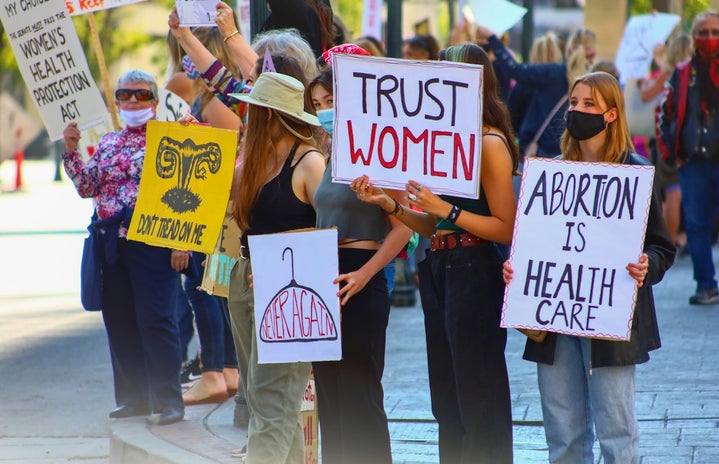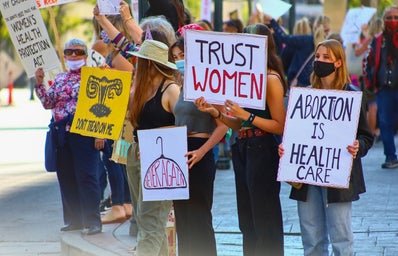I don’t know about anyone else, but this upcoming election is scaring the hell out of me. Do you all remember the insanity of the presidential debate? I remember watching it with my roommates and laughing way too hard at the ridiculous things that were said.
That being said, this is likely one of our generation’s most important presidential elections, and it’s our responsibility to stay informed about how the results could impact our futures. Whether you are eligible to vote or not, it’s essential to know the politics of where you live, as it likely has a significant impact on you or the people around you.
One of the hot topics of this election is women’s health, specifically reproductive health. Even though I personally would like it if our bodies were not a government matter and our country’s leaders could instead stay focused on issues like climate change or the economy, for some reason, the health of women and their bodies is at stake this election. Therefore, having an informed decision on who we support in this election will determine the future of women’s health. To help you make an informed decision, here is a rundown of the things you should know about how each party could impact the future of women’s health.
Trump’s Agenda
Abortion Access
One of the critical points former President Donald Trump has made clear in his campaign is that he was responsible for the overturning of Roe v. Wade. He claims that this decision was a matter of states’ rights and that each state should individually determine how they want to handle abortion care and pregnancy tracking. In doing so, 14 states have completely banned abortion with very few exceptions, and several have limited abortion access to soon after conception.
The policy proposal that is Project 2025 aims to limit access even further. Project 2025’s Mandate for Leadership states that it “calls for the government to comply with laws that prevent federal funding of abortion” and “for federal support for alternatives to abortion, including adoption.” So, while tip-toeing around the phrase “ban abortion,” Trump’s agenda still insinuates that he will do the best they can to make it harder for people to get abortions. Although Project 2025 explicitly states that it was not written by Trump, it was written by a coalition of organizations from the conservative movement, many of which are former members of the Trump administration. And let’s not forget what he said in the presidential debate against Kamala Harris. Trump outlandishly claimed that Democrats are in support of abortions even after birth (completely false).
Contraception
In addition to taking credit for the overturning of Roe v. Wade, Trump’s administration placed several restrictions on the availability of funding for contraception. During his campaign, he said that states could restrict access to contraceptives. This was the extent to which he discussed the topic of contraception, but Project 2025 says that contraceptive pills that prevent pregnancy after sex are a “potential abortifacient.” Additionally, in 2019, Trump’s administration rewrote the federal Title X program, which is a federal family planning program that offers contraceptive access to low-income communities. Because of this rewrite, family planning clinics that offer abortion services are no longer eligible for the program. And clinics that are participating in the program are prohibited from referring patients to other clinics with abortion services. Luckily, the Biden-Harris Administration reversed these changes to the Title X program, but Project 2025 wishes to restore Trump’s previous regulations. Concerning the approval of Texas Medicaid blocking payments to clinics that provide abortion, Trump’s second term would likely weaken the Affordable Care Act policies that cover contraception, which would restrict contraception and medication abortions.
Maternal and Women’s Health Care
The Project 2025 policy initiative looks to restrict federal spending for Medicaid, which would likely decrease coverage for postpartum patients and produce challenges for low-income women needing health services before, during, and after pregnancy. As if none of that was terrible enough, while researching this article, I found something I wasn’t aware of before: the protective regulations that stated that women who have previously terminated a pregnancy could not be discriminated against on race, color, national origin, sex, age, and disability when receiving health care were eliminated by the Trump administration
Harris’s agenda
Abortion Access
One of the things Vice President Kamala Harris has made clear during her campaign is her support for reproductive freedom. She has been avidly outspoken about reproductive liberty, and she has made the differences between her and Trump on this topic clear. Harris has endorsed the restoration of the federal standard that existed under Roe v. Wade to guarantee the right to abortion. While Trump takes credit for overturning this standard, Harris has clarified that she disagrees with the Supreme Court’s decision in Dobbs v. Jackson Women’s Health Organization. Throughout the Biden-Harris administration, they have made conscious efforts to decrease the effects of the ruling through actions such as the enforcement of federal protections for abortion care and the reinforcement of the protective regulations towards non-discrimination policies in health care that Trump had previously eliminated. Additionally, Harris has shown her support for the FDA’s expansion of access to medication abortion through pharmacies and telehealth. She has highlighted her discontent with the prohibiting of mailing abortion medications and supplies. Her administration has additionally directed federal programs like the HHS, NIH, and CDC to conduct more research on the harms of restricting abortion access to women’s health.
Contraception
Vice President Kamala Harris has made it clear that women should have equal access to contraception across the country. Recently, the Biden-Harris administration proposed a new rule to provide millions of women with more affordable options for contraceptives, with coverage for no-cost, over-the-counter contraception without a prescription. The administration also restored the regulations from the Title X program that Trump demolished, now requiring that family planning programs offer a full range of contraceptives, abortions, and pregnancy counseling. This brought a lot of family planning clinics back after Trump’s presidency, which drove nearly a third of them to leave the public health community.
Harris’s election would continue to build off of the efforts of strengthening access to contraception that the Biden-Harris Administration has worked hard on for the past four years.
Maternal and Women’s Health Care
The Biden-Harris administration issued a “Blueprint on Maternal Health” to address the Maternal Health Crisis, which contains 50 actions for agencies to undertake to improve maternal health. Harris made a statement about this blueprint, saying she hopes the steps will “move us closer to a future where every woman and every mother has the care she needs to thrive.” Harris intends to cut down the rates of maternal mortality and morbidity. Additionally, Harris has made it a goal for her administration to work toward reducing disparities in women’s health. With high rates of maternal mortality among Black and American Indian/Alaska Native women, Harris hopes to increase maternal health equity by addressing these racial and ethnic disparities. She also hopes to build off of the Biden-Harris administration’s efforts to close gaps in women’s health research and to expand the access and coverage of women’s health through enhancing Medicaid.
Hopefully, this article helped review how both parties want to impact women’s health in the upcoming election. I could go on and on listing more things both parties have done in the past and their plans for the future regarding women’s health. Still, I think my point is clear: Harris is making a conscious effort to stand for women’s health, while Trump wishes to take away reproductive freedom.
This election will determine the future of women’s health for the next four years. It’s up to us to make a difference in this election. Whether you are eligible to vote or not, stay informed, make your voice heard, and choose to support women’s health.


